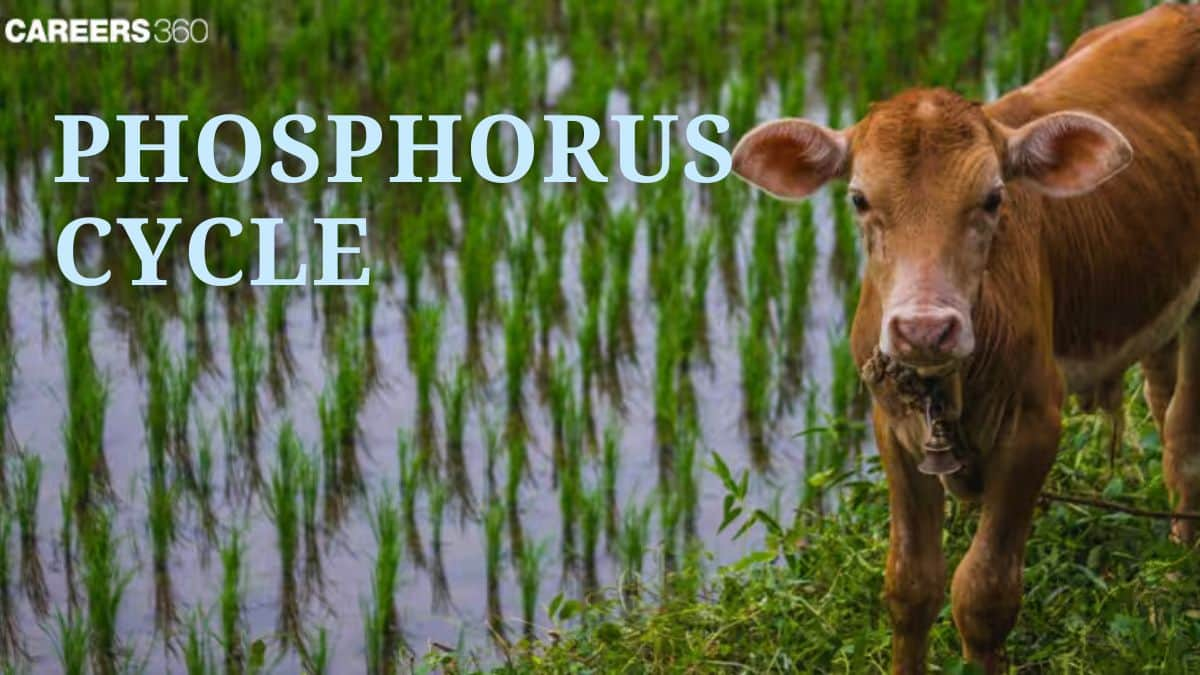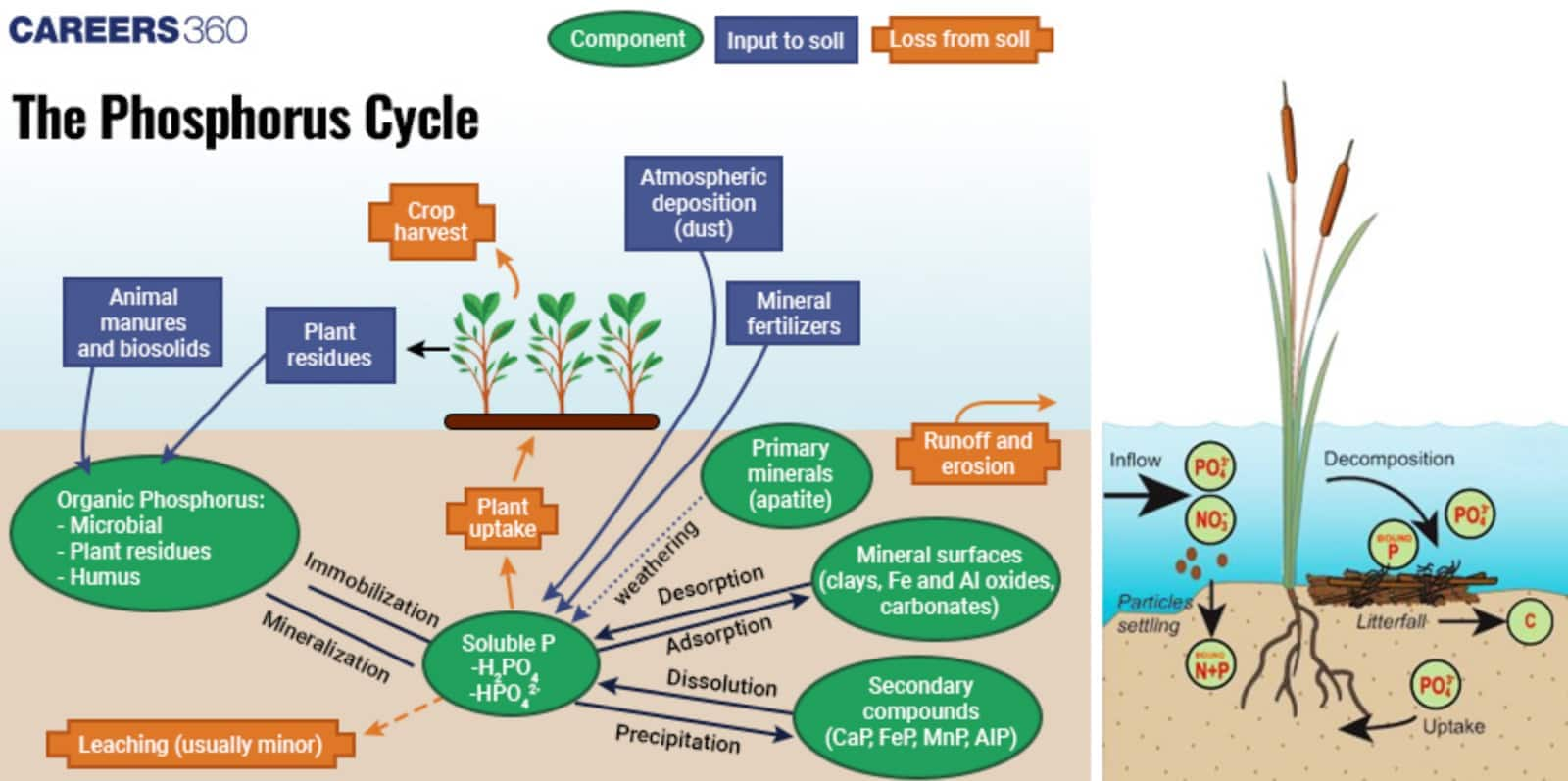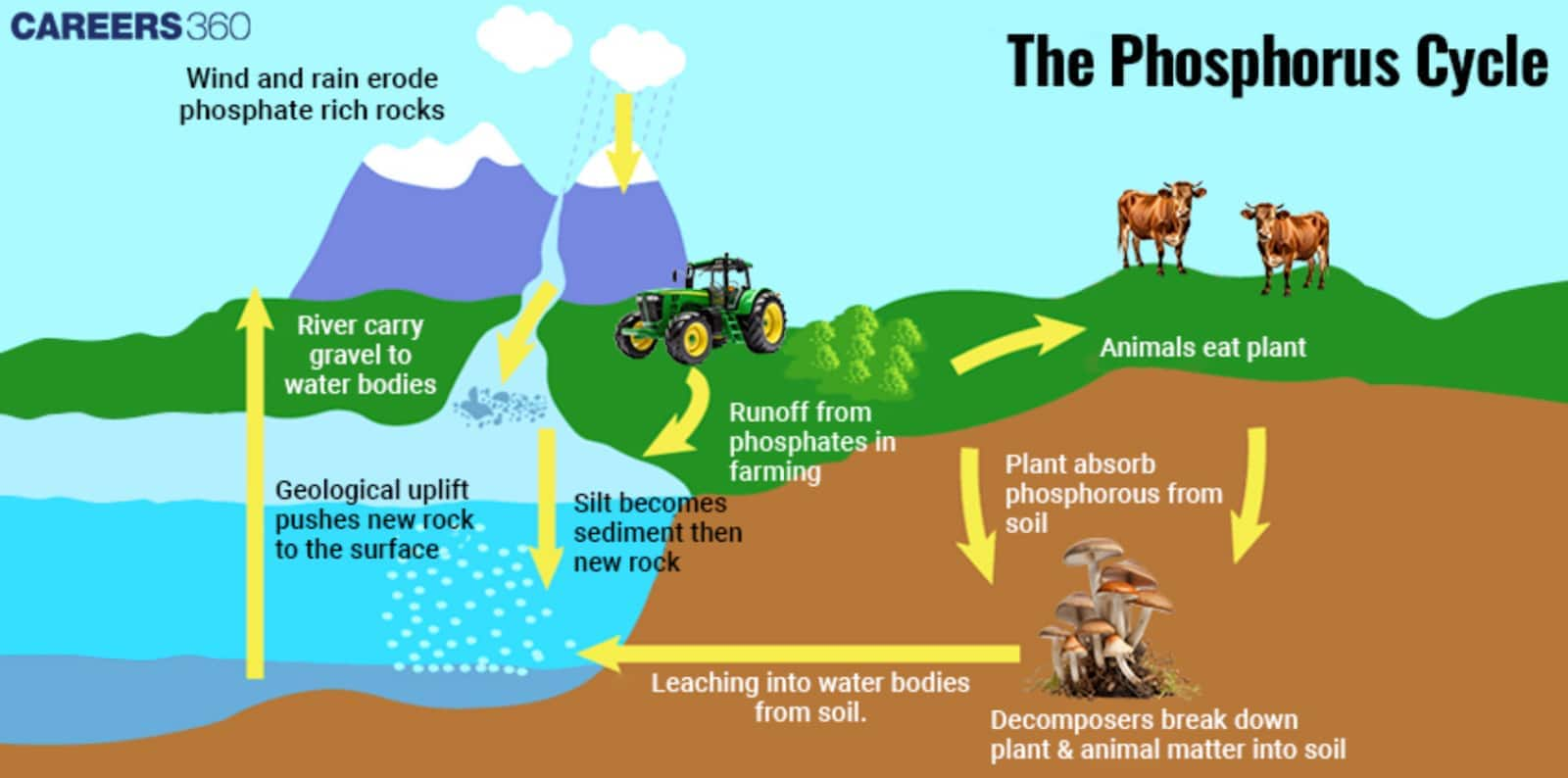Phosphorus cycle: Definition, Steps, Examples, Importance, Topics
The phosphorus cycle is a biogeochemical cycle that moves phosphorus through rocks, soil, water, and living organisms but not the atmosphere. Essential for DNA, RNA, ATP, and cell membranes, it sustains plant and animal growth. A vital NEET and Class 12 Biology topic in ecology.
This Story also Contains
- What is a Phosphorus Cycle?
- Sources of Phosphorus in Nature
- Steps of the Phosphorus Cycle
- Human Impact on the Phosphorus Cycle
- Importance of the Phosphorus Cycle in Ecology
- Phosphorus Cycle NEET MCQs (With Answers & Explanations)
- Recommended video for Phosphorus Cycle

What is a Phosphorus Cycle?
The phosphorus cycle is defined as the circulation of phosphorus in the lithosphere, the hydrosphere, and the biosphere. Unlike other biogeochemical cycles, phosphorus does not circulate in the atmosphere as a gas. Phosphorus is vital for all living things, needed in the advancement of DNA and RNA synthesis, ATP and cell membranes. It is released from rocks through weathering, enters soil and water as phosphate ions. It is then absorbed by plants, transferred to animals through ingestion and returned to the soil through decomposition. This cycle is vital for maintaining phosphorus availability in ecosystems and supporting biological productivity.
Sources of Phosphorus in Nature
The phosphorous in nature is listed below:
Rocks and minerals
The largest accumulations of phosphorus are in sedimentary rocks of marine origin. Fertilisers are prepared from phosphate ores such as apatite. Over time, known as the ecological time scale, these minerals undergo weathering to release phosphorus in the soil and the water.
Soil and Water
Phosphorus is in the form of phosphate ions (PO32-) in the soil and dissolved orthophosphate in water bodies. On land, phosphorus has mobile particles and can be found in the soil and within particulate and dissolved-organic matter while in the water, it converts between sediment and water column.

Steps of the Phosphorus Cycle
The steps of the phosphorous cycle in the ecosystem are described below:
Weathering of Rocks
Phosphorus is mobilized through the release process from rocks and minerals due to weathering. It is a process through which phosphate minerals disintegrate as a result of physical and chemical weathering.
Absorption by Plants
The phosphate ions (PO43-), is taken up by plants through the root system from the soil. Phosphorus is needed in plant nutrition as it is a constituent of DNA, RNA, ATP and cellular membranes.
Consumption by Animals
Like other nutrients phosphorus is ingested by the animals from plants or other animals. Phosphorus is body stored and is essential in many tissues hence playing key roles in cell structuring, bone formation and energy production.
Decomposition and Mineralisation
Overall, phosphorus cycles in basic ways; it is produced from ingredient deposits when plants and animals decay and mineralized when nitrogen by microorganisms or decomposition. Decomposers act upon organic matter discharging phosphate ions to the soil solution at the same time.
Sedimentation in Aquatic Systems
Phosphorus can also be transported from terrestrial to aquatic systems using run-offs and soil erosion. Phosphorus in the aquatic environment can sink and deposit onto bottom deposits at a later time.
Geological Uplift
The sedimentary phosphorus which has been mobilized into oceans over geologic time scales may experience other geological uplift processes whereby phosphorus-containing sediments are brought to new terrains and landforms or weather anew.
Phosphorous cycle diagram

Human Impact on the Phosphorus Cycle
Human activities have significantly altered the phosphorus cycle, leading to both beneficial and detrimental effects on ecosystems and the environment:
Agriculture and Fertilizer Use
Phosphate fertilizers are widely used intensively for increasing the rate of crop production. accidently, when fertilization is excessive then it leads to the accumulation of phosphorus in water bodies resulting in eutrophication which is a process by which the production of oxygen is countered resulting in the formation of non-sustainable ecological systems.
Industrial Activities
Some of the industrial fields include mining and manufacturing which release phosphorus into the environment through the discharge of wastewater and emissions. These activities can make phosphorus get into the water and the soil and thus interfere with the ecosystems of the region.
Waste Management Issues
Often phosphorus is released into water systems by poor disposal of organic wastes, sewage and agricultural runoff. Wastewater treatment plants commonly found in urban areas fail to remove phosphorus, and the amounts end up disposed of in rivers, lakes, and coastal regions.
Environmental Consequences (Eutrophication)
Phosphorus pollution is one of the major impacts of human activities in aquatic ecosystems that lead to the occurrence of eutrophication. An overabundance of phosphorus causes the growth of algae, which decreases water transparency, prevents penetration of sunlight and expends the oxygen supply on the decomposition of dead algae. This interrupts the life systems of water bodies, hurts fish and might culminate in the development of hypoxic zones known as dead zones.
Importance of the Phosphorus Cycle in Ecology
The phosphorus cycle is essential because it recycles phosphorus, a vital nutrient, through soil, water, plants, and animals, ensuring ecosystem health and productivity.
Role in Plant and Animal Growth
Phosphorus is a key component of DNA, RNA, ATP, and phospholipids, making it crucial for cell structure and energy transfer. Plants need phosphorus for root development, flowering, and seed formation, while animals require it for healthy bones and teeth. Inadequate phosphorus affects growth, reproduction, and metabolic processes.
Ecosystem Balance and Productivity
The phosphorus cycle maintains the level of phosphate ions in soil and water, supporting plant productivity and, in turn, higher trophic levels. Any shortages or excesses that could disturb ecosystem stability. In aquatic ecosystems, too much phosphorus can cause eutrophication, reducing biodiversity and overall ecosystem health.
Phosphorus Cycle NEET MCQs (With Answers & Explanations)
Important topic that are asked in NEET exam from the given topic are:
Basics and Definition of Phosphorus Cycle
Steps of the Phosphorus Cycle
Sources of Phosphorus
Practice Questions for NEET
Q1. The natural reservoir of phosphorus is
Fossils
Sea Water
Animal Bones
Rock
Correct answer: 4) Rock
Explanation:
Phosphorus is found naturally in rocks, particularly phosphate rocks.
As these rocks erode, phosphorus is discharged into the soil and water. Phosphorus is carried up by plants from the soil and passes up the food chain as animals consume plants. Rocks are the main natural source of phosphorus because it does not exist in the atmosphere as a gas like other elements like carbon or nitrogen do.
Hence, the correct answer is option 4) Rock.
Q2. Which one of the following will accelerate phosphorus cycle?
Volcanic activity
Weathering of Rocks
Rainfall and storms
Burning of fossil fuels
Correct answer: 2) Weathering of rocks
Explanation:
The phosphorus cycle is sedimentary. The Reservoir pool of phosphorus in the ecosystem is the earth's crust or lithosphere. The weathering of rocks accelerates the phosphorus cycle which supports biological functions such as DNA synthesis and energy transfer.
Hence, the correct answer is option 2) Weathering of rocks
Q3. Which one of the following is not a gaseous biogeochemical cycle in the ecosystem?
Sulphur Cycle
Phosphorus Cycle
Nitrogen Cycle
Carbon Cycle
Correct answer: 2) Phosphorus Cycle
Explanation:
Phosphorus is a major constituent of biological membranes, nucleic acids, and cellular energy transfer systems. Many animals also need large quantities of this element to make shells, bones, and teeth.
The natural reservoir of phosphorus is rock, which contains phosphorus in the form of phosphates. When rocks are weathered, minute amounts of these phosphates dissolve in soil solution and are absorbed by the roots of the plants.
Hence, the correct answer is option 2) Phosphorus cycle.
Also Read:
Recommended video for Phosphorus Cycle
Frequently Asked Questions (FAQs)
Thus, sustainable management involves such practices as decreasing application rates of fertilizer products, increasing effluent treatment to mitigate phosphorus release, introducing soil protection measures, and increasing the public’s ecological literacy to counter phosphorus contamination of environments.
The phosphorus cycle outlines the factors through which phosphorus flows in the earth’s structures by geological, biological, and chemical processes. It is important because phosphorus is a critical part of DNA, RNA, ATP and cell membranes with a central role in energy transfer and life processes associated with an organism’s growth.
Phosphorus is one of the nutrients that move in the soil, water, and among the different forms of life. It is in rocks, accessed by weathering, taken by plants from the soil, ingested by animals, returned to the soil through burying, and can get to water by percolation.
Hoe farming (use of fertilizers), and industries (wastewater), fail in proper waste disposal and contribute to the increased level of Phosphorus in water. This leads to decreased dissolved oxygen levels, eutrophication, effects of the algal blooms on the aquatic lives and disturbance of the natural ecosystem balances.
Interfering with the phosphorus cycle results in eutrophication which brings about a poor quality of water, poor habitat for the aquatic animals, and most of which develop a low oxygen region known as the ‘dead zone’. It also has implications for the state of biodiversity and the balance of ecosystems.